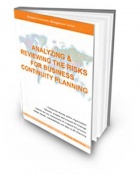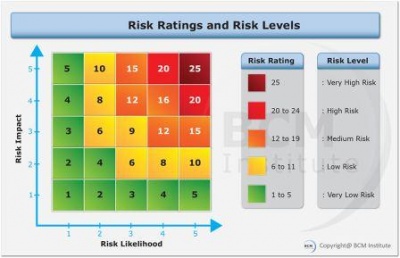Difference between revisions of "Risk Appetite"
Jump to navigation
Jump to search
| (19 intermediate revisions by 2 users not shown) | |||
| Line 1: | Line 1: | ||
| − | |||
{| style="margin-left: 0px; text-align: left; font-style: none; width:100%; font-weight: none; background: #F0F0F0; border:1px" | {| style="margin-left: 0px; text-align: left; font-style: none; width:100%; font-weight: none; background: #F0F0F0; border:1px" | ||
|- | |- | ||
| − | | '''1.''' [[Risk|Risk]] Appetite is the amount and the type of risks | + | | '''1.''' [[Risk|Risk]] Appetite is the amount and the type of risks an organization is willing to take in or absorb. This is the amount and type of risk an organisation will pursue or retain. |
| − | {{Template:BL- | + | |
| − | + | ||
| − | + | {{Template:BL-OR-5 banner}} | |
| − | + | ||
| + | '''Risk Appetite''' in Operational Resilience: | ||
| + | |||
| + | '''''Notes (1):''''' is the aggregate level and types of risk the [[Board| board]] and [[Executive Management|executive management]] are willing to assume to achieve an organisation’s strategic business objectives. | ||
| + | |||
| + | '''''Notes (2):''''' is consistent with applicable capital, liquidity, and other requirements and constraints.'' | ||
| − | |||
| − | |||
| − | + | {{#ev:youtube|pdNrTuYXSNw|400}} | |
| + | </div> | ||
| + | <br/> Related Terms: [[Risk_Likelihood|Risk Likelihood]], [[Risk_Impact|Risk Impact]], [[Risk_Rating|Risk Rating]], [[Risk_Assessment|Risk Assessment]], [[Risk_Level|Risk Level]], [[Risk Appetite]], [[Risk Tolerance]], [[Risk Threshold]], [[Period_of_Disruption|Period of Disruption]], [[Operational Resilience]], [[Governance]]. | ||
| − | [[File:3D BCM Series Analyzing and Reviewing in the context of BCM Books.jpg|thumb| | + | [[File:3D BCM Series Analyzing and Reviewing in the context of BCM Books.jpg|thumb|right|140px|Analysing And Reviewing The Risks For Business Continuity Planning ]] |
| − | {{BcmBoK 2 CL 2B}}<br/> <br/> {{BcmBoK 2 CL 2C}}<br/> <br/> {{BcmBoK 2 CL 2D}} | + | {{BcmBoK 2 CL 2B}}<br/><br/> {{BcmBoK 2 CL 2C}}<br/><br/> {{BcmBoK 2 CL 2D}}<br/><br/> {{ORBoK P2 CL 3OR}}<br/><br/> {{ORBoK P2 CL 3ORA}} |
| | ||
| − | + | {{Template:BLCoursesBanner}} | |
| − | |||
| − | |||
| − | |||
| − | |||
{{Bcm Institute Source}} | {{Bcm Institute Source}} | ||
| Line 31: | Line 31: | ||
[[File:BCM Institute Risk Ratings and Levels.jpg|thumb|right|400px|BCM Institute Risk Ratings and Levels.jpg]] | [[File:BCM Institute Risk Ratings and Levels.jpg|thumb|right|400px|BCM Institute Risk Ratings and Levels.jpg]] | ||
| + | |||
'''2.''' Amount and type of [[Risk|risk]] that an [[Organization|organization]] is willing to pursue or retain. | '''2.''' Amount and type of [[Risk|risk]] that an [[Organization|organization]] is willing to pursue or retain. | ||
| Line 44: | Line 45: | ||
{{ENISA Source}} | {{ENISA Source}} | ||
| − | [[Category:BCM Institute Glossary]] [[Category:BCM Institute Crisis Management Glossary]] [[Category:BCM Institute DR Glossary]] [[Category:BcmBoK 2 CL 2B]] [[Category:BcmBoK 2 CL 2C]] [[Category:BcmBoK 2 CL 2D]] | + | [[Category:BCM Institute Glossary]] [[Category:BCM Institute Crisis Management Glossary]] [[Category:BCM Institute DR Glossary]] [[Category:BcmBoK 2 CL 2B]] [[Category:BcmBoK 2 CL 2C]] [[Category:BcmBoK 2 CL 2D]] [[Category:BcmBoK 2 CL 2OR]] |
Latest revision as of 11:21, 13 January 2024
2. Amount and type of risk that an organization is willing to pursue or retain.
(Source: ISO 22301:2012 – Societal Security – Business Continuity Management Systems - Requirements) - clause 3.49
3. Total amount of risk that an organizationis prepared to accept, tolerate or be exposed to at any point in time.
(Source: British Standard BS25999-1:2006 Code of Practice for Business Continuity Management)
4. Willingness of an organization to accept a defined level of risk.
(Source: Business Continuity Institute - BCI)
(Source: ENISA - the European Network and Information Security Agency. BCM & Resilience Glossary)



